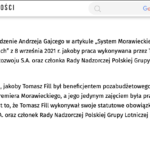Poland has revealed a draft of its hydrogen strategy. It wants to utilize various technologies, even though Europe puts preference on green hydrogen, which is generated from renewable energy sources. In a move to maintain their access to the EU coffers, Poles have proposed a more neutral classification in comparison to the popular hydrogen rainbow – writes Wojciech Jakóbik, editor in chief at BiznesAlert.pl.
Hydrogen road map
The draft, titled „Poland’s hydrogen strategy by 2030 with a perspective until 2040” has been submitted for public consultations. „Poland has the opportunity to use the scientific potential and expert experience in hydrogen technologies based on its own innovative technologies,” the authors of the report claim. „The strategy’s vision and overarching goal is to grow a hydrocarbon industry in Poland by, among others, developing domestic patents and hydrocarbon technologies, as well as using them to achieve climate neutrality and maintain the competitiveness of the Polish economy.
The strategic goals include, among others, bringing into use a 1 MW power to gas installation based on Polish technologies, opening a facility where hydrogen is produced using, among others, electrolysis from biomethane, waste gases, natural gas with the usage of CCS/CCU, or using pirolysis and other alternate technologies of hydrogen production, owning electrolyzers with 2GW capacity that run on renewables in 2030.
A legal framework is necessary to achieve this. „It is of utmost importance to create a legislative framework for hydrogen as an alternative transport fuel, draft regulations for the functioning of a hydrogen market and, later on, prepare a legislative hydrogen package – regulations which will define the details on how the market should function, and which will implement the relevant EU regulations, as well as introduce a system of incentives to produce low-emission hydrogen,” the strategy says.
The document includes a thorough description of the actual situation in the EU hydrogen industry, hydrogen strategies of selected EU states, as well as of Japan and Australia. These last two sates are especially pertinent examples, because they reach for solutions other than green hydrogen. Poland wants to follow a similar approach. „The ability to use the potential of renewable energy sources (RES) is limited by technical and weather conditions. It will be possible to generate economically competitive hydrogen from nuclear sources once the first nuclear block is opened, which according to the plan is to take place in 2033. For years Poland has been researching technological solutions for the hydrogen industry. Hence, today the country already has solutions of high technological readiness. In order to commercialize them, the industry needs to receive support to develop in a dynamic and stable way by 2030,” the document states. This is why the value chain described by the strategy authors includes, among others, hydrocarbon steam reforming, coal gasification, separating coke-oven gas as well as HTR (high temperature reactor technology).
Replacing the hydrogen rainbow with an emission criterion
Poles have a proposition that stands in contrast to the European Commission’s rainbow terminology, as it allows hydrogen to be generated from various sources. So far, hydrogen has been classified on the basis of the source from which it was produced: green hydrogen is produced from renewables, blue and turquoise from gas, violet from nuclear power, grey from refining and black from coal. Poles prefer an approach, which in their opinion will be less discriminatory.
Enter the term „conventional hydrogen”, i.e. one that is generated from fossil fuels. Thanks to it, today Poland ranks 5th on the European ranking of hydrogen production. The annual hydrogen production in Poland is about one million tons. The gas is produced by, among others, the following companies: Azoty – 420 thousand tons, Lotos – 145 thousand tons, Orlen – 145 thousand tons, Jastrzębska Spółka Węglowa – 75 thousand tons. Conventional hydrogen is the cheapest, but also generates the highest amounts of emissions, which is why it goes against the EU climate policy and is under pressure from new regulations. The second new term is „low-emission hydrogen”, which is generated from non-renewable sources, or renewable sources with a small carbon footprint suggested at a level lower than 5.8 KG CO2/kg H2. „We should replace the arbitrary process of assigning a 'color’ to hydrogen depending on how it was generated, with a precise, numerical definition of hydrogen’s emissions level. The amount of CO2 generated per one kilogram of hydrogen in the entire production chain should be the criterion. Such an indicator would allow producers to adjust their technology to meet the desired standards,” the strategy proposes. „A cost-effective solution would be to use the hydrogen generated as a byproduct of chemical processes (the so-called waste hydrogen), which was qualified as low-emission, because the emissions were generated during different processes, in which they were inevitable,” the authors add, suggesting that grey hydrogen from refineries should be utilized. The third kind of hydrogen is „renewable”. It is generated in the process of electrolysis thanks to energy from renewable sources and an emission level under one kilogram of CO2 per one kg of hydrogen. „Today Poland’s ability to use the potential of renewables to generate hydrogen is limited, because of the lack of adequate facilities, and low commercialization of the existing technologies. The system solutions dedicated to managing the surplus of energy from renewables where hydrogen is generated in the process of electrolysis when demand for power drops, does not work either. The main reason for this is the high cost of installing electrolyzers and the high demand in the system for power from renewables,” the authors admit. Together with the development of renewable energy in Poland the potential of renewable hydrogen will expand, but changing the definition will make it possible for H2 to grow also thanks to nuclear energy, because violet hydrogen (from nuclear power) is to become equal to the green one (from renewables). „The competitive advantage of hydrogen generated in nuclear power plants is based not only on the lack of emissions, but also on the possibly of large-scale production (economies of scale). It is one of the cheapest ways to generate hydrogen. „Producing hydrogen in nuclear power plants makes the most sense during the so-called night valleys, when NPPs may be forced to lower their capacity, which has a negative impact on their efficiency,” the strategy authors explain. They also add that the plan includes HTR technology, which is to be developed in cooperation with Japan, which was included in the report as an example in the review of existing hydrogen strategies for a reason.
„It is also pertinent to incorporate the strategies of Polish companies that may be based on other ways of hydrogen generation. It was important to include a rule that widens the possibilities of using hydrogen from electrolysis, but also one that depends on the emission levels of grey hydrogen. This will be an important change, one that we will fight for on the EU level in line with the European principle of technological neutrality, so that as big a number of entities as possible could take this opportunity,” Michał Kurtyka, the Minister of Climate and the Environment, said in an answer to BiznesAlert.pl during a conference on which the hydrogen strategy was presented.
The game to tap into the EU coffers
In response to questions from BiznesAlert.pl, the Ministry of Climate and Environment explained that on the 9th of December the representatives of ministers for climate, energy and the environment – COREPER, met to negotiate how the EU hydrogen strategy should look. Poland’s proposition to support hydrogen technologies depending on their emissions level was adopted. The conclusions on this topic were adopted during the meeting of ministers for energy of the Council of the European Union. „Those technologies that generate no or low emissions and thus will bring Europe closer to climate neutrality will be promoted. Green projects will have the biggest support, but thanks to this classification we are not excluding the HTR technologies,” Ireneusz Zyska the Deputy Minister for Climate and Environment told us. „We are just starting. We will speed up after 2030. In the current decade we will develop the market and prepare the framework for further growth. The entry threshold, prices and availability of technologies force us to first clear the trails. In the next decade hydrogen technologies are to become common and cheaper,” he argued.
„The EU bankrolling low-emission technologies, not just green hydrogen, offers an opportunity to Poland, as well as other states with large industries, such as Germany. It also makes it possible to develop competencies and a hydrogen market with the existing assets, and enables a gradual move to hydrogen that causes less emissions, as well as H2 generated with power from large renewable facilities, such as offshore wind farms,” Zyska summed up.
This means that if the EU maintains its support for various kinds of hydrogen, the EU funds, e.g. the Connecting Europe Facility, which was used to bankroll innumerable projects that were important for Poland’s energy security (e.g. the LNG terminal and Baltic Pipe), could be used for hydrogen projects, for instance as part of the EU goal to adapt the gas infrastructure to transport hydrogen and other renewable gases, such as biomethane. Thus, Poland could keep its access to EU money for energy transition, despite the fact that it wants to use gas and other transition technologies (apparently in the hydrogen sector as well), which are increasingly more often penalized in Europe, like in the high-profile decision of the European Investment Bank, which decided to stop supporting gas projects. Polska Hydrogen Ready wants to keep on receiving funds from the EU despite the peculiarities in its energy and hydrogen strategies, by marking individual projects (e.g. Baltic Pipe) as endeavors that facilitate the transition.
However, the success during the COREPER meeting should not be treated as the final battle. „This position was adopted by the Council and it determines how hydrogen should be handled in the EU legislation. It will impact the Council’s position with regard to drafting specific regualations. It should also have some effect on the approach of the European Commission. It refers mostly to what is included in the plan determined by the EU hydrogen strategy from July 2020,” Paweł Wróbel, CEO of Gate Brussels explained. „We should remember we are in the midst of building a hydrogen market, which has been stressed by the EC as well. This is why at this stage there is room not only for green hydrogen, even though this kind of hydrogen is to be the target one as it is generated with RES. When analyzing how the future legal and financial EU framework will handle various hydrogen technologies, one should also take into consideration the position of the European Parliament. I expect that it will argue for limiting hydrogen other than green as much as possible. The document adopted by the EU Council in December las year is not a legal act, it’s only a conclusion. The future of hydrogen will be determined during the negotiations on specific regulations and directives, so it is still an open question,” the experts argued.
To be continued
The game for access to the EU treasury with hydrogen as leverage will be continued. Poland wants to stick to its specificity, similarly to the energy sector. This approach is balanced and I have called for it in my other articles. According to the hydrogen strategy, at the turn of 2021 and 2022, a legislative package for the gas is to be drafted. It will include regulations that will implement the EU legislation, regulate the mechanics of the hydrogen market, and provide a system of incentives to produce the gas. Whether Poland will be able to use the full potential of its hydrogen economy depends on the administration in Warsaw. The government will either use the upcoming opportunities to develop new industries and reach for the potential of RES and green hydrogen, or sit on its laurels and use a diversified hydrogen mix to protect the status quo in the energy sector. If the various hydrogen technologies are approved, Poland will have to face changes that are not as revolutionary, but it should not be an excuse to perpetuate the status quo, which does not strengthen the competitiveness of Poland’s economy.









